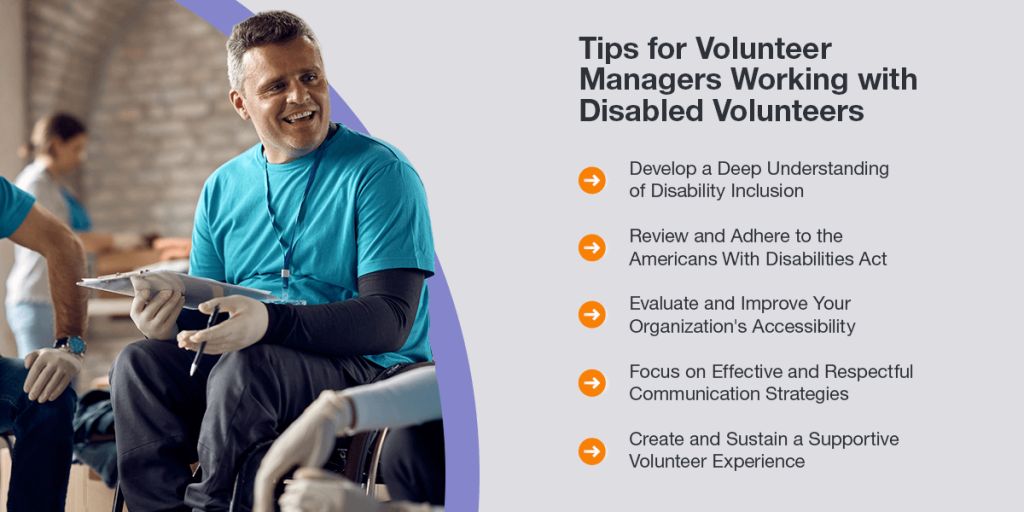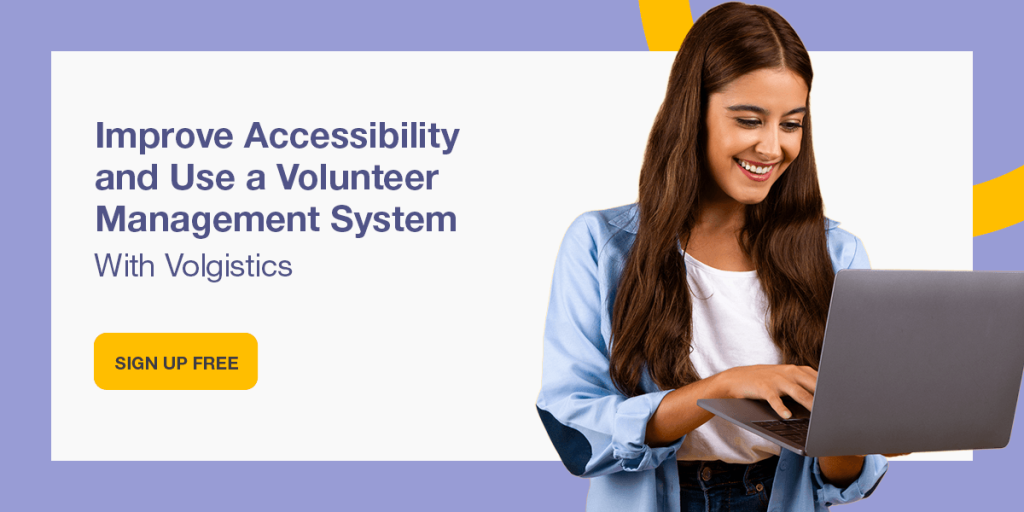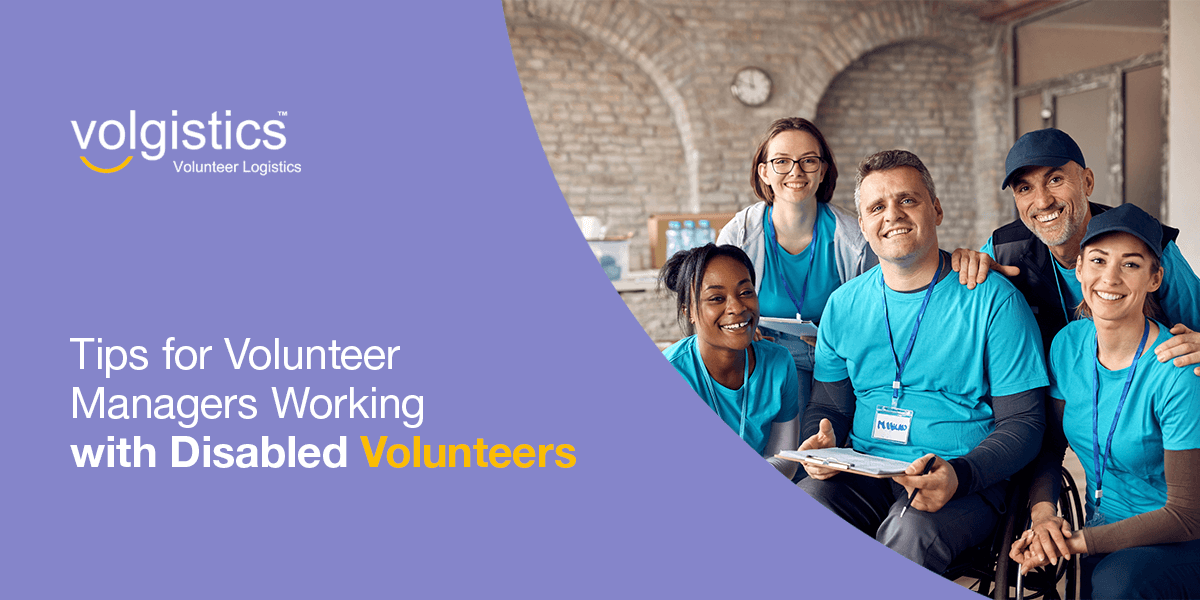Volunteers are the heart of numerous organizations, and embracing diversity helps enrich an organization’s mission. Engaging diverse volunteers creates inclusive opportunities for individuals of all capabilities while strengthening communities. However, as a volunteer manager, you likely want to be more knowledgeable when working with disabled volunteers.
Our guide provides essential tips for making volunteering accessible, from learning a deep understanding of disability inclusion to providing reasonable accommodations and fostering a supportive and respectful culture in your organization.
1. Develop a Deep Understanding of Disability Inclusion
Disability inclusion ensures individuals with disabilities are integrated into various aspects of life, such as employment, education, and community involvement. Beyond encouraging participation, removing barriers to accessibility means everyone can contribute to their community and thrive. To truly include people with disabilities, design opportunities with people’s diverse needs in mind.
In the United States, around 26% or 61 million people have a disability. These disabilities can range from physical conditions such as visual impairments, hearing limitations, and mobility issues requiring a wheelchair, to various sensory, intellectual, and mental disabilities. It’s crucial to note that some disabilities are visible, while others, such as chronic pain or autism spectrum disorder, aren’t always visually apparent.
To foster this culture, your organization should conduct accessibility audits, provide proper inclusion training, and gather input from individuals with disabilities. Once you’ve done the research, actively provide volunteer accessibility tips within your group to help create more inclusive experiences for your members and attract diverse volunteers. Building this organization-wide understanding enhances engagement and strengthens community impact.
2. Review and Adhere to the Americans With Disabilities Act
The Americans with Disabilities Act (ADA) was enacted to safeguard people with disabilities from inequity, ensuring they have access to services, jobs, and other public daily activities. Listening to input from disabled individuals while proactively reviewing the ADA is a huge part of how you can work better with disabled volunteers.
While volunteers are technically not employees, the spirit of non-discrimination should extend to volunteer opportunities. Your organization should design and open programs that individuals with disabilities can join. To make this possible, you must provide reasonable accommodations, which are adjustments or modifications that make volunteer work accessible for disabled individuals. This allows them to participate, perform, and contribute to your organization’s goals.
Examples of reasonable accommodations include assistive devices or technology for volunteers with visual impairments or learning disabilities, quiet spaces for volunteers with sensory sensitivities, and accessible parking spaces for people with mobility challenges. Reasonable accommodations vary depending on the needs of your disabled volunteers, which is why getting their feedback is important.
Under the ADA, there are recommended Web Content Accessibility Guidelines (WCAG). As an example, your organization can adapt more accessible web content and mobile apps that disabled volunteers can use to do their tasks.
3. Evaluate and Improve Your Organization’s Accessibility
A thorough evaluation of your organization’s accessibility involves assessing both physical and digital spaces to identify potential barriers that may prevent disabled participants from fully contributing. Here are accessibility tips for volunteers to consider when improving their physical and digital spaces:
- Physical accessibility: Ensure there are ramps, accessible restrooms, parking spaces, and clear signage to accommodate disabled applicants and members at volunteer locations. Consider the needs of volunteers with visual impairments by providing large print materials or tactile signage. Modifying volunteer schedules can also work for members who need longer breaks or require going to regular medical appointments.
- Digital accessibility: Review your website, online platforms, and communication methods to follow the WCAG. Use clear and simple language and easy-to-read fonts on your website. Accessible online platforms with visual information should also be translatable into audible speech for visually impaired applicants. Consider making online volunteer application forms accessible to more disabled applicants.
4. Focus on Effective and Respectful Communication Strategies
Be mindful of the language you use and the way you communicate to ensure everyone feels valued and understood. Remember that sensitivity is key before making assumptions about a person’s abilities or needs. Treat everyone with dignity and respect, and create a safe space for open and honest communication.
Here are two ways to effectively and respectfully communicate when working with disabled volunteers:
- Use first-person language: This approach emphasizes the individual before their disability, such as saying “a person with a hearing disability” rather than “a deaf person.” Though first-person language is often preferred, some individuals, specifically from younger generations, may choose identity-first language. It’s best to ask how someone prefers to be addressed.
- Practice active listening: Active listening involves expressing genuine interest and respect through verbal and non-verbal cues, such as directly acknowledging a person’s thoughts or mirroring their body language and tone. Maintain active listening in conversations with all your volunteers to support good communication across the team.
5. Create and Sustain a Supportive Volunteer Experience
Creating a supportive volunteer experience involves clearly defined, flexible roles that welcome diverse participants. Make volunteer work accessible by offering accommodations early in the process, such as providing a suggestion box in application forms. Invest in training sessions for members with disabilities to help them become prepared and more confident in their role. You can also tailor orientation and training to various learning styles, clearly introducing your organization’s goals and values.
Educate your organization continuously on disability issues by inviting knowledgeable speakers. For example, you can invite American Sign Language (ASL) experts to help your members better understand people who communicate using ASL. Sharing real stories and practical knowledge shifts attitudes, benefiting the entire organization and helping disabled members feel appreciated, capable, and confident in their contributions.

Improve Accessibility and Use a Volunteer Management System
Building an inclusive volunteer program means prioritizing accessibility and tailored support for every member, including volunteers with disabilities. Volgistics offers a customizable volunteer management system designed to meet the unique needs of your organization. Our platform helps you create accessible application forms, track rendered hours, and streamline communication within a single platform.
With over 25 years of experience, Volgistics is a reliable partner for volunteer leaders, providing innovative software solutions that help simplify operations and empower volunteers. Our platform allows you to efficiently manage volunteer profiles, organize schedules, create tailored application forms, and send targeted communications to volunteers. We also provide unlimited support at no additional cost.
Ready to foster a more accessible and supportive volunteer environment? Schedule a live demo to see how our platform works, or contact our team to learn more.


